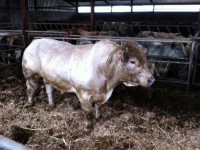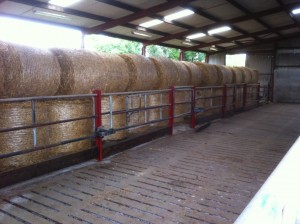
Beef Animal Health Problems
The most common problems causing Beef production problems are:
- Lungworms
- Rumen Fluke
- Liver Fluke
- Lice and Ticks
- Lameness and hoof infections
- Acidosis
All of these either are parasites that live on the cows energy and cause her to have a reduced feed intake due to lack of appetite. Its estimated that a bull with a bad case of lice is using at least one kilo of compound feed per day to combat this.
Lungworm, liver fluke and rumen fluke are becoming very prevalent in todays grass based Beef system. A case of fluke will cost you serious lack of performance in terms of reduced thrive and body weight loss. An annual Dosing programme for all types of fluke is vital for any farmer. Keep in mind when you dose for rumen fluke for example that the dose will only kill the adult fluke, it cannot kill the eggs ready to hatch in the animal. You must dose again 3 to 4 weeks later after these eggs have hatched and before they plant eggs of their own. If you do not dose the second time you will be back to square one again in a few months.
Solutions
- Have a dosing regime and stick to it rigidly. Talk to your vet about when to dose and with what.
- Remember to dose a second time within 3 to 4 weeks when dosing for fluke to kill the younger fluke.
- You will never eradicate all parasites, all you can do is reduce them to a manageable level.
- Be very careful when buying in new stock. Quarantine them until they have gone through a dosing programme.
- Talk to one of our Ruminant Advisory team.
Rumen upset
This is a common cause for loss in performance. The rumen is a 50 gallon stomach that is tasked with taking in very hard to digest forage such as grass and preparing this grass for digestion. It does this by mixing the grass with large amounts of liquid and saliva and allowing billions of “good” bugs in the rumen to start the process of breaking down the cellulose in grass and silage. These bugs like a stable environment with a constant temperature and a stable almost neutral acid or PH level. When we introduce rapidly fermentable feed into the rumen it causes the PH level in the Rumen to become more Acidic. This drop in PH can kill off some of the billions of bugs in the rumen and hence we get a Rumen upset.
We often see Rumen upsets in animals on ad lid diets or put out onto lush leafy grass. This is rapidly fermentable feed material and causes a drop in Rumen PH.
Feeding crimped barley and straights in my experience can cause a lot of problems. It is vital when feeding high cereal diets that animals get consistent feed. You should have a fibre source such as straw and access to lots of clean drinking water (if you would not drink it then its no suprise that the animal will be slow to drink too)
In theory feeding lots of straights can work fine but all too often this falls down at farm level and problems occur. A simple change such as a farmer going away on holidays and a relief worker feeding the wrong level can have serious if not terminal side effects.
When we formulate our feeds we take great care to balance rapidly fermentable energy sources such as Barley, with slower to digest energy sources such as Maize. We use good fibre sources such as Soya hulls and Beet pulp to again balance the feed at the point of digestion. We also include rumen buffering agents and yeast to further help minimise the chances of a Rumen upset.
Solutions to prevent Rumen upset
- Do not change the diet drastically. Any change in diet should be done over a course of weeks not days.
- If you are feeding straights be very careful as to the level you are feeding and frequency that you are feeding it.
- Always have access to clean drinking water, if you would not drink it then it is not clean.
- Always provide a fibre source such as straw to animals. In most cases those animals that need fibre will eat it.
Housing and Hyigene
This may sound simplistic but Housing and Hyigene is a vital step in getting good Beef production performance.
Common problems are:
- Overcrowding. This is the case in 99% of sheds in the country including my own. We are all guilty of buying extra cattle if we think the price is right. Bad grazing conditions mean
that these animals often have to be housed before other animals are finished. Overcrowding means they do not have enough feed space so intake is down and they are standing for long periods so thrive goes down also.
- Clean sheds. It is a difficult and messy job to clean out a Beef unit. Even the best designed slatted unit is a pain to get clean in the summer. Why bother? If you dont make some attempt to clean out your shed regularly then you are asking for a build up of disease over the months or years. Also steel gates and dividers rot at an alarming rate when sheds are not cleaned out and soon you are faced with an expensive repair bill. A vacumn tank or two of water through a 2 inch hose followed by a shovel brush and power washer makes a fabulous job of a Beef unit in my experience. A lick of (lead free) paint also puts some pride back into a shed.
- Water is a massive issue at housing. Lack of water or restricted acces to water and poor water quality has a massive negative effect on Beef production. Beef animals need massive volumes of water to ruminate the fodder they take in. A lack of water means that even a slight case of acidosis will depress their performance. You will be left wondering what the problem is and why the cattle are not performing till you realise the water situation is not up to scratch.

